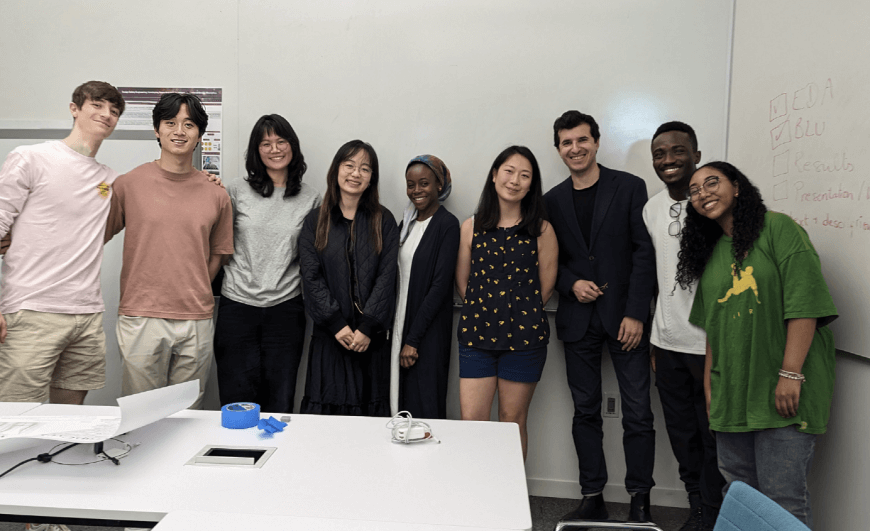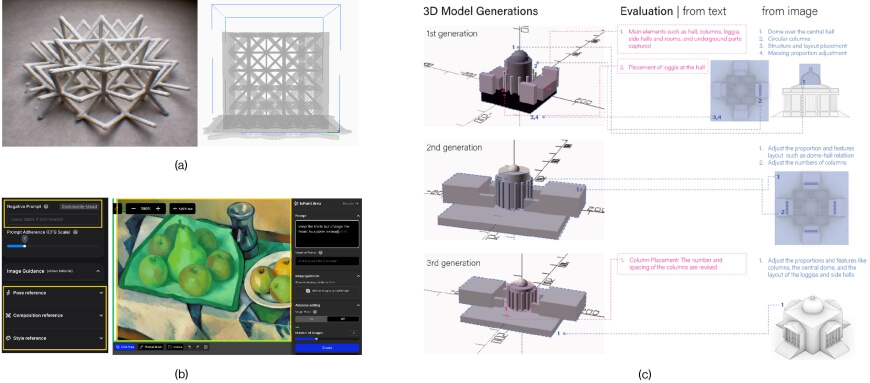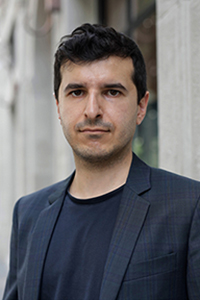News
Seven students took ES138 this past spring: From left: Jonas Hansen, Justin Liu, Yiko Li, Jingfei Huang, Fatima Mamu, Joyce Lee, Prof. Alexandros Haridis, course assistant Joachim Asare, and Hebron Geremew
Last spring, a class at the Harvard John A. Paulson School of Engineering and Applied Sciences (SEAS) aimed to combine computation with traditional design concepts to broaden the ways architects and designers can approach how they solve design challenges. “ES138: Computing, Spatial Design, and Human Values” introduced students to a range of design and computational concepts, then challenged them to design final projects that could solve challenges in a range of design spaces, including robotics, materials science, architecture and fashion.
“We study computation and design and the way they influence each other,” said Alexandros Haridis, Lecturer on Engineering Design. “Each of the students was able to use one or more of the techniques I introduced in class to show the issues we’re interested in – such as usability, structure or ethics – within those individual domains can be solved computationally.”
Haridis structured the class around two computational approaches to design: “rules-based design” and “data-driven design.” In rules-based design, new objects must follow predetermined rules that govern everything from construction materials to color selection to specific shapes within the final project. A specific brand of car might have a mandatory shape for its grilles or bumpers, for example, or all the paintings of a specific style might require similar brushstrokes. These rules are called “shape grammars,” and once determined for a category of objects, provide a way to determine if new objects meet the criteria. For instance, if a new design for a Harley-Davidson motorcycle doesn’t meet the shape grammar of its handlebars, it can’t be called a Harley-Davidson motorcycle.
“The students went through a series of exercises in which they defined their own grammar to describe design languages,” Haridis said. “Shape grammars originate from linguistic grammars. But because the rules are made with shapes as opposed to words, this enables the rigorous computational study of spatial objects across design disciplines and scales.”
While rules-based design is a longstanding tradition, students also learned about how artificial intelligence (AI) relates to design disciplines. Machine learning has recently driven the increasing use of data-driven classification and generative modeling in design. Programs using these methods take for example images of related objects as input and categorize them according to certain design features, or use them to derive new objects that mimic those already in the set. Designers that use this approach no longer need to explicitly define rules for a design object, because machine learning algorithms can compute new objects simply by looking at pre-existing sets.
“This course offers an integrated and intriguing perspective on computational design, particularly in the areas of shaping grammar and rules to deconstruct the complex system of design, design values, and AI,” said Jingfei Huang, who’s pursuing a Master in Design Engineering (MDE) at SEAS and the Harvard Graduate School of Design. “It has provided me with a new perspective on how each artificial object can be broken down into its smallest units, computed, and reassembled in an understandable way. This approach not only helps designers evaluate and reinforce each step of the design process but also enhances the understanding and application of computation in the design-making process.”
Seven students took the course in its initial offering. Several were MDE students like Huang, but there were also undergraduates studying computer science, robotics and the humanities.
“SEAS is very diverse in that it has all of these different academic disciplines, but in one way or another they’re all focused on separate areas of either engineering design or applied science,” Haridis said. “Most of this material, when it comes to design, isn’t available in other classes. Just studying computer science doesn’t put you in position to know how exactly those abstract computational concepts can be transferable to design. I wanted to come up with techniques that can inform and empower students to look at problems in design, then describe and solve them with those techniques.”
Examples of ES138 final projects included a) printed material specimen and 3D material simulation from “Shape Grammar-Based Metamaterial Design for Energy Absorption,” b) evaluation of OpenArt’s user interface from Yiko Li's “Improving Human-AI Alignment through Interface Constraints, and c) analysis of GPT-4 on computer aided design model generation from Jingfei Huang's “Architectural Synthesis: GenAI-assisted 3D Architectural Creation and Evaluation.”
For her final project, Huang used the generative AI program ChatGPT to devise a script that could be used to more efficiently create code for computer aided design software, but other students came up with far different applications for the course material. Joyce Lee, another MDE student, analyzed the shape grammar of certain metamaterials, then used those rules to devise new materials tailored for maximum energy absorption.
“I was initially drawn to ES138 because of its focus on computational perspectives in design, which I believed could provide a unique lens to explore and define values in a structured and innovative way,” Lee said. “I was looking for an opportunity to bridge the gap between theoretical knowledge and practical application, ensuring that my values in design were not just conceptual but also tangible and actionable. The course’s emphasis on computational techniques provided the perfect platform to combine these diverse influences, allowing me to put my learning into practice in a meaningful way.”
Among the undergraduates taking the course, Jonas Hansen, A.B. ‘24 (computer science), looked at the shape grammar of robots built to move across various terrains, and devised a way to better design them for specific environments before reaching the time-consuming building and testing phases. Justin Liu, A.B. ‘25 (computer science and statistics), looked at the aesthetic shape grammar of cable suspension bridges, then used generative AI to design new bridges. Other projects included a computational workflow for turning fabric scraps into luxury clothing, and method of using computational methods to explore the historical significance of knot and cross motifs in traditional art.
“The students were very engaged, internalized the methods and used them effectively to formulate interesting and useful proposals and solutions,” said Fawwaz Habbal, who was Executive Dean for Education & Research at SEAS when Haridis proposed the class in the summer of 2023, and is co-director of the MDE program. “Students enjoyed the course and were very engaged in the methodology of the course. The learning from this course provided the students with avenues to use computing methods to frame and solve challenges in multidisciplinary ways.”
Cutting-edge science delivered direct to your inbox.
Join the Harvard SEAS mailing list.
Scientist Profiles
Alexandros Haridis
Lecturer on Engineering Design
Press Contact
Matt Goisman | mgoisman@g.harvard.edu





